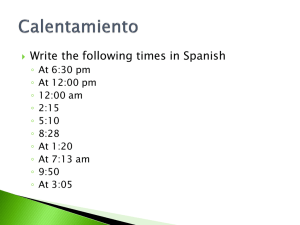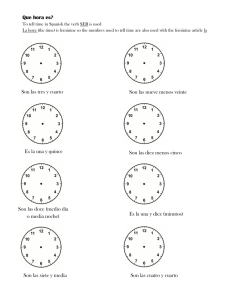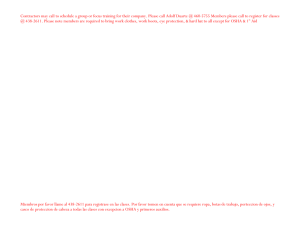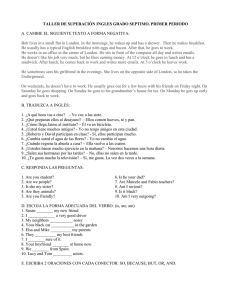Dialogue Telling the time
Anuncio
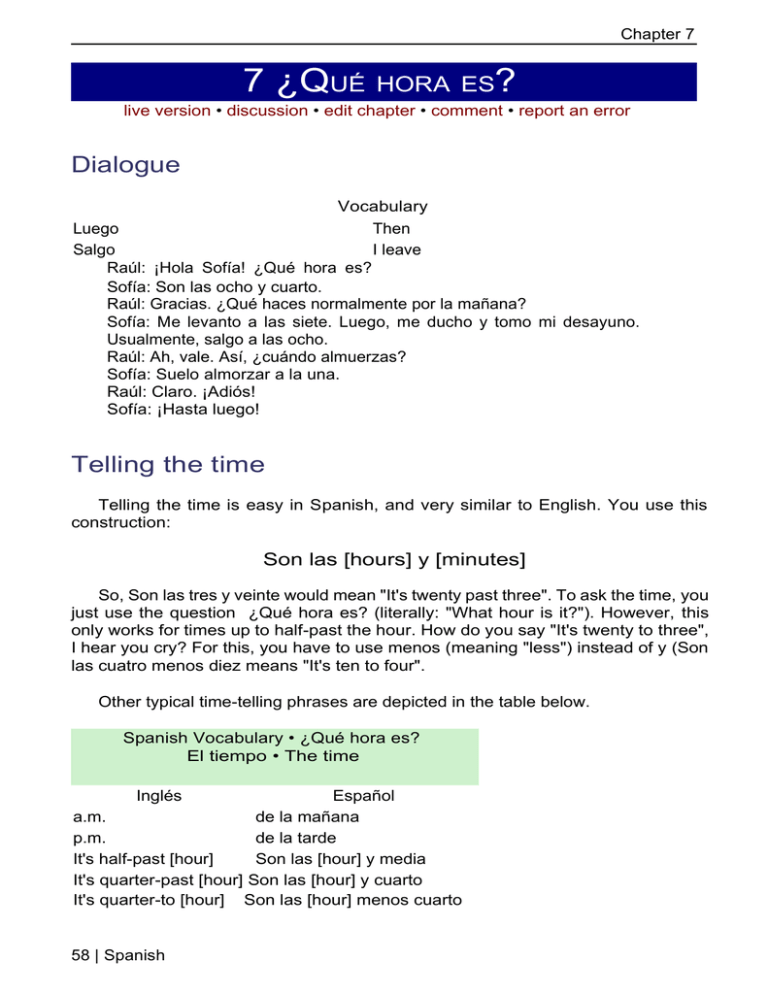
Chapter 7 7 ¿QUÉ HORA ES? live version • discussion • edit chapter • comment • report an error Dialogue Vocabulary Luego Then Salgo I leave Raúl: ¡Hola Sofía! ¿Qué hora es? Sofía: Son las ocho y cuarto. Raúl: Gracias. ¿Qué haces normalmente por la mañana? Sofía: Me levanto a las siete. Luego, me ducho y tomo mi desayuno. Usualmente, salgo a las ocho. Raúl: Ah, vale. Así, ¿cuándo almuerzas? Sofía: Suelo almorzar a la una. Raúl: Claro. ¡Adiós! Sofía: ¡Hasta luego! Telling the time Telling the time is easy in Spanish, and very similar to English. You use this construction: Son las [hours] y [minutes] So, Son las tres y veinte would mean "It's twenty past three". To ask the time, you just use the question ¿Qué hora es? (literally: "What hour is it?"). However, this only works for times up to half-past the hour. How do you say "It's twenty to three", I hear you cry? For this, you have to use menos (meaning "less") instead of y (Son las cuatro menos diez means "It's ten to four". Other typical time-telling phrases are depicted in the table below. Spanish Vocabulary • ¿Qué hora es? El tiempo • The time Inglés Español a.m. de la mañana p.m. de la tarde It's half-past [hour] Son las [hour] y media It's quarter-past [hour] Son las [hour] y cuarto It's quarter-to [hour] Son las [hour] menos cuarto 58 | Spanish ¿Qué hora es? Notes • If there aren't any minutes, just say son las cinco ("It's 5 o'clock") or son las once ("It's 11 o'clock"). • Remember: son means "they are", so son las... only works for numbers greater than one. To say "it's one o'clock", you have to say Es la una. Examples • • • • Son las ocho It's 8 o'clock Son las nueve y media It's half-past nine Son las seis menos cuarto It's quarter-to six Son las dos y veinte de la mañana It's 2:20 a.m. When? So, you now know how to tell the time in Spanish. Now let's use it to describe when something happens. To do this, you use a las followed by the time as described above (a las tres means "at 3 o'clock"). But what if you don't know a specific time? What about just "In the evening"? Just use por la, followed by one of the entries in the table (por la noche means "at night"): Spanish Vocabulary • ¿Qué hora es? Los tiempos del día • The times of the day Inglés Morning Afternoon Night Español Mañana Tarde Evening Noche Notes • Since it's always "por la", this means that these times-of-day are all feminine. Examples • • A las ocho de la mañana, tomo mi desayuno. At 8:00am, I eat breakfast. Por la tarde, le gusta ver la tele. Wikibooks | 59 Chapter 7 • In the evening, He likes watching TV. Por la noche, les gusta mucho beber leche. At night,they love drinking milk. Time-related Adverbs It's all very well knowing how to say that you do things at a particular time, but what about more habitual actions? What do you do usually? Normally? Sometimes? Spanish Vocabulary • ¿Qué hora es? El tiempo • The time Inglés Usually Normally Often Sometimes Occasionally Rarely Soler Español Usualmente Normalmente A menudo A veces De vez en cuando Ocasionalmente Raramente To be in the habit of Notes • You should notice that all the words ending in "ly" in English end in mente in Spanish. To turn an adjective into an adverb: take the feminine form of the adjective, then add mente. • Thus, normal, raro, ocasional and usual are all adjectives. • Also, ruidosamente, tranquilamente, etc, are adverbs (you met tranquilo and ruidoso in lesson 4...) • Soler is a UE stem-changing verb (suelo, sueles, suele, solemos, soléis, suelen), and it is followed by the infinitive (Suelo comer queso con pan, meaning "I usually eat cheese with bread"). Examples • • • • A veces, bebemos vino tinto, pero nunca vino blanco. Sometimes, we drink red wine, but never white wine. Suelo vivir en pisos; vivir en una casa es muy difícil. I usually live in flats; living in a house is really difficult. De vez en cuando, juego al ajedrez, pero usualmente, practico judo. Sometimes, I play chess, but usually I do judo. Normalmente a las cinco de la tarde, juego al futból. Normally at 5pm, I play football. 60 | Spanish
